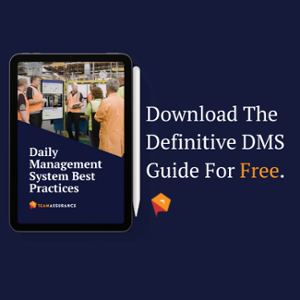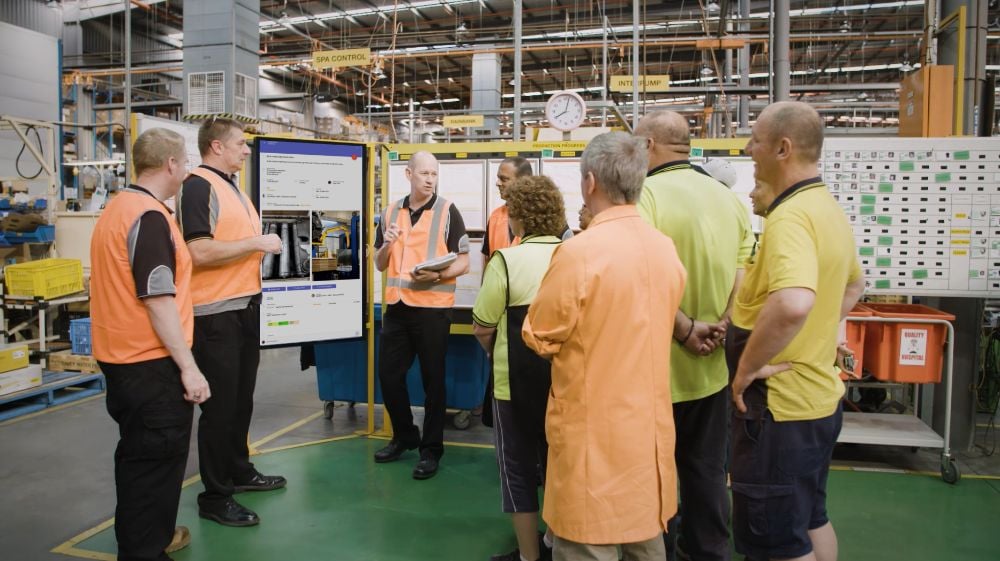3 Tips to Optimise Your Daily Huddles

Paul Dunlop discusses his top considerations to maximise the potential of your stand-up meetings and to optimise your huddles.
All too often the daily huddle misses the mark and simply becomes a waste of time for the people attending. This can be the case for any number of reasons; the bottom line is that we are missing the single biggest opportunity to engage our people and improve our process if we fail to optimise this tool.
For me the daily huddles should be the hub of your team and organisation's continuous improvement activity. The simple act of gathering the team together, looking at the shared visual objectives, and our processes’ actual performance against them is critical. You should be having an intentional (and meaningful) conversation about sustaining and improving the situation. This is a key component in becoming a true learning and improvement organisation.
A daily huddle is about physically bringing people together and connecting them as a team through a defined set of process objectives. These objectives should be visual and each member of the team should understand the nature / purpose of the metric. The metric should clearly visualise how the process has actually performed to the expectation. The meeting should facilitate a conversation to discuss what has worked well, what has not, and what are the opportunities to sustain the gains and correct the deviations.
So let’s discuss a few key considerations that will optimise your daily huddles.
1) Focus on Structure and Content
The structure and content of the board is our first consideration. We must ensure that the content is meaningful and tailored for the audience. After all, the meeting is designed to promote engagement with a functional team and facilitate a good quality flow of information. This starts with consultation with, and inclusion of, the team in developing the content prior to implementation. Once implemented and functioning this should be an ongoing process with a visual board evolving multiple times.
In a manufacturing setting a visual board typically follows the flow of P (People), S (Safety), Q (Quality), C (Cost), D (Delivery) as the primary pillars. These can differ, but this generally frames the conversation around the right things. It is formatted to ensure that we are focussed on the most important things first – our people, everyone’s safety and the needs of our customer. A daily huddle should review metrics from the previous process cycle and review lead and lag indicators. The huddle should also observe trends over longer time periods such as week to week, month on month.

The structure and content of the board should stimulate engagement from the team through a review of the metrics and generate follow up activity. A huddle is designed not just to talk about things - it is about action too. This activity must be captured, documented and visualised in some way to facilitate follow ups and accountability. Thus the final part of the board should be a visualisation of the issues raised, and the actions to occur as a result of discussion and agreement with the team and their leader.
 A team huddle visual board can be a manual board on a whiteboard, it can be a digital board or it can be a hybrid of both. What is important is that we remove any barriers for our people - their voice should be heard daily through feedback and tangible outcomes happening as a result. Of course, we’d lean then towards a fully digital solution for acccessibility and transparency.
A team huddle visual board can be a manual board on a whiteboard, it can be a digital board or it can be a hybrid of both. What is important is that we remove any barriers for our people - their voice should be heard daily through feedback and tangible outcomes happening as a result. Of course, we’d lean then towards a fully digital solution for acccessibility and transparency.
Solutions like TeamAssurance have a distinct advantage in ease of use, managing, automating and streamlining the visibility / allocation of activity. Particularly when you consider the need to do this across functions, hierarchical levels and geography.
2) Appoint a Meeting Leader
A good huddle relies on good facilitation and leadership. This starts with having a clear agenda and an agreed set of meeting values. It is fundamental that a huddle stays on track, and on time - 10-15 minutes is more than adequate. The huddle must be conducted in an efficient way that still remains a respectful and safe place for all participants. The role of the meeting leader is very much in the mould of a coach. The visual board is the team’s ‘scoreboard’ if you will and the coach speaks to the board whilst providing the necessary feedback.
The coach’s role then is about asking good quality questions. The coach should be probing the team to uncover the reality of what is happening in Gemba to form the basis of learning and improvement conversations.

This of course is predicated on the huddle being a safe space where people are comfortable in speaking up, raising concerns and putting forward their ideas. There must be trust in the leader and within the team. Individuals must feel comfortable being vulnerable in asking for help and support, seeking guidance and taking responsibility for mistakes.
A good huddle is one that has energy. They are a great place for improvement when the team are positive, optimistic, and relish the challenge of making their process better by the day.
3) Aim for Consistency in the Stand-Up Meeting
The mark of success with daily meetings is consistency and discipline. That means that the meetings happen at the same time, in the same way, day in and day out - without compromise. This discipline is crucial, as developing the right habits and learning to practice Lean, Plan Do Check Adjust (PDCA) thinking relies heavily on the repetition of following the form.
Continuous improvement cannot happen in one offs or stop-start inconsistency. The moment we prioritise a reactive demand over a structured CI activity we severely compromise the integrity of the message.
One More Quick Tip: Define Actions and Accountabilities
Another key point around optimising the huddle is that the meeting promotes follow up activity and feedback. Items that are raised for action are duly given a clear timeline, someone is allocated ownership and there are touchpoints to visualise the status and provide feedback on progress.
Again, the huddle must dispel the myth of “we’ve told them a hundred times and nothing ever happens” by ensuring that activities are documented, visual until closed out satisfactorily and regular feedback occurs.
So, why invest in optimising the huddle?
Good quality daily huddles, with a tiered approach, will ensure that people at all levels of the organisation are focused on the right things each day. This promotes inclusion, connection and engagement as well as alignment on strategic objectives. Tiered huddles should also provide the appropriate support and means for escalation.
This enables people to have agency to solve problems, learn by doing, and drive daily incremental improvement. Ultimately, we are endeavouring to give people a voice and a place to be heard every single day through a visual medium. A medium that supports ideas, creativity and innovative thinking through Lean methodologies.
Chris Larkins (SVP of Global Operations - Seqirus) discusses the impact of daily management.
Viewing the Daily Huddle as part of the greater C.I. Framework
The daily huddle aids in the alignment of our people, processes and systems. However, we must remember that it is one part of a greater continuous improvement framework. Other Lean tools like standardised problem solving techniques, Standard Operating Procedures (SOPs), and a Tiered Daily Management process that supports our full PDCA loop are also key to achieving success over both the short and long term.
This illustration demonstrates how we designed the TeamAssurance platform to avoid locally optimised, disconnected ‘Point Solutions’ (digital or analog) that can hinder your progress towards the organisation's goals.

If you’re a business in need (or a consultant with clients in need) and you'd like to explore the opportunities that digital-aids to Lean tools provide contact us for a demonstration of the TeamAssurance platform today.


